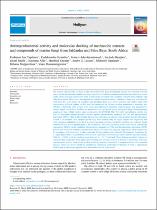| dc.description.abstract | The number and diversity of drugs in the tuberculosis (TB) drug development process has increased over the years, yet the attrition rate remains very high, signaling the need for continued research in drug discovery. In this study, crude secondary metabolites from marine fungi associated with ascidians collected from Saldanha and False Bays (South Africa) were investigated for antimycobacterial activity. Isolation of fungi was performed by sectioning thin inner-tissues of ascidians and spreading them over potato dextrose agar (PDA). Solid state fermentation of fungal isolates on PDA was then performed for 28 days to allow production of secondary metabolites. Afterwards, PDA cultures were dried and solid-liquid extraction using methanol was performed to extract fungal metabolites. Profiling of metabolites was performed using untargeted liquid chromatography quadrupole time-of-flight tandem mass spectrometry (LC-QTOF-MS/MS). The broth microdilution method was used to determine antimycobacterial activity against Mycobacterium smegmatis mc2155 and Mycobacterium tuberculosis H37Rv, while in silico flexible docking was performed on selected target proteins from M. tuberculosis. A total of 16 ascidians were sampled and 46 fungi were isolated. Only 32 fungal isolates were sequenced, and their sequences submitted to GenBank to obtain accession numbers. Metabolite profiling of 6 selected fungal extracts resulted in the identification of 65 metabolites. The most interesting extract was that of Clonostachys rogersoniana MGK33 which inhibited Mycobacterium smegmatis mc2155 and Mycobacterium tuberculosis H37Rv growth with minimum inhibitory concentrations (MICs) of 0.125 and 0.2 mg/mL, respectively. These results were in accordance with those from in silico molecular docking studies which showed that bionectin F produced by C. rogersoniana MGK33 is a potential inhibitor of M. tuberculosis β-ketoacyl-acyl carrier protein reductase (MabA, PDB ID = 1UZN), with the docking score observed as −11.17 kcal/mol. These findings provided evidence to conclude that metabolites from marine-derived fungi are potential sources of bioactive metabolites with antimycobacterial activity. Even though in silico studies showed that bionectin F is a potent inhibitor of an essential enzyme, MabA, the results should be validated by performing purification of bionectin F from C. rogersoniana MGK33 and in vitro assays against MabA and whole cells (M. tuberculosis). | en_US |

